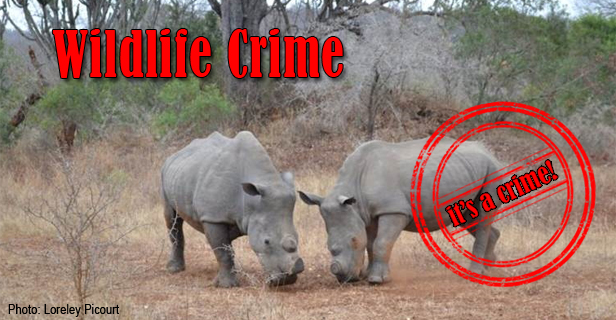

"Poaching and wildlife trafficking have a devastating impact on communities, on the environment and on security. Poachers and other criminals are driving elephants, rhinos, tigers and many other species to the verge of extinction, around the globe. Criminals are destroying local livelihoods, upsetting fragile ecosystems and hindering social and economic development. They are fuelling violence and corruption, and undermining the rule of law."
Yury Fedotov
Executive Director of the United Nations Office on Drugs and Crime (UNODC)
Wildlife and forest crime is a rapidly growing industry, yielding enormous profits for the criminal networks, ranking alongside trafficking in drugs, arms and people. It affects us all, with quick profits leading to devastating losses of wildlife in the future. Animals are being killed for body parts or for the exotic pet trade. Trees are cut down and forests are destroyed to make furniture or other wood products. The impact of the crime is global, although the illicit trade is predominantly in and between the regions of Africa and Asia.
Wildlife and forest crime includes the taking, trading, importing, exporting, processing, possessing, obtaining and consumption of flora and fauna (animals, birds, fish, plants and trees) in contravention to national and international law.
The total value of the illegal trade in wood-based products, usually from and within East Asia and the Pacific, is worth an estimated US$17 billion. Southeast Asia is home to seven per cent of the world's old-growth forests and many unique trees, and the region is suffering heavily from a rapid rate of deforestation, much of it illegal. The illicit wildlife trade is generating a further US$2.5 billion from East Asia and the Pacific alone. The devastating impact of this crime can be seen in the numbers of animals decimated by the crime.
A global response is essential to effectively tackle this transnational crime which moves its illicit commodities across thousands of kilometres and many borders. Poverty exacerbates the crime, as desperate people turn to illegal means of obtaining the means to survive. But ultimately crime does not promote social and economic development, trapping many countries in an endless circle of greed, exploitation and economic despair. Countries must work together to introduce measures that decrease demand, address problems in existing legislation, strengthen law enforcement and judicial systems, share best practices on detection and prosecution, and gather data.
Time is not on our side: wildlife and forest crime is growing in size and scope, some animal species are being driven to extinction, the environment is being destroyed. In his message for World Wildlife Day on 3 March the Executive Director of UNODC Yury Fedotov, called for wildlife crime to be recognized as a serious crime under the UN Convention against Transnational Organized Crime: " I also urge the international community to acknowledge that this is an intergenerational crime and that the offences committed today are denying the heritage of this beautiful planet to future generations. Everyone becomes impoverished because of this activity. To confront this crime we need to join a global partnership united by the same belief: it's time to get serious about wildlife crime."
Wildlife and forest crime is not only having a devastating impact on wildlife and forests, but also on people and their livelihoods. It undermines the efforts of rural communities and indigenous peoples to manage their natural resources in a sustainable way. Vulnerable communities are exploited by the criminals and may become involved due to their perilous economic situation.
Fragile ecosystems are destroyed and habitats degraded which can lead to a loss of revenue from tourists. It threatens biodiversity and could lead to endangered species becoming extinct.
Wildlife crime threatens national and regional security, weakens the rule of law and corrupts officials. The criminal proceeds undermine legitimate businesses, lead to a loss of tax revenue and weaken criminal justice systems, by taking advantage of a lack of legislation and regulation.
Wildlife and forest crime is particularly acute in developing countries as under-resourced governments often lack the capacity to regulate the exploitation of their natural resources.
As the illegal trade in wildlife has increased in its scale and nature, more international attentional has been drawn to tackling this issue. A global response is necessary as illicit trafficking in wild fauna and flora is transnational, supplying consumption that often takes place thousands of kilometers from the source and transits several countries.
The United Nations Office on Drugs and Crime (UNODC)'s Global Programme for Combating Wildlife and Forest Crime (GP) is trying to link existing regional efforts into a global system. The programme is working with the wildlife law enforcement community to ensure that wildlife crime, illegal logging, and related crimes are treated as serious transnational organized crimes.
UNODC provides technical assistance to strengthening capacity to prevent and combat the crime on a regional, national and local basis.
UNODC also works with other international organizations and agencies as part of the International Consortium on Combating Wildlife Crime (ICCWC), which brings together a wide range of expertise. The ICCWC partners are the Convention on International Trade in Endangered Species of Wild Fauna and Flora (CITES) Secretariat, INTERPOL, the United Nations Office on Drugs and Crime, the World Bank and the World Customs Organization.
The ICCWC aims to increase the risk of detection and punishment for the perpetrators of wildlife crime so that they face a formidable and coordinated response. It works with the wildlife law enforcement community to help bring those engaged in wildlife crime to justice.
The ICCWC Wildlife and Forest Crime Analytic Toolkit, developed by UNODC provides comprehensive guidance in analysing administrative, preventive and criminal justice responses to wildlife and forest crime. The Toolkit is available in English, French and Spanish.